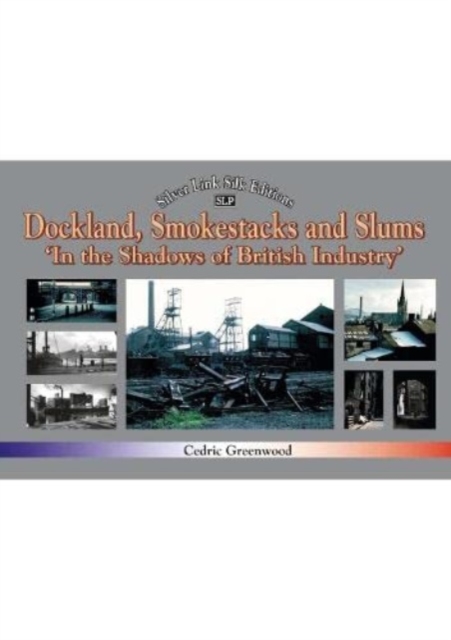Dockland, Smokestacks and Slums: In the Shadows of British Industry

Dockland, Smokestacks and Slums: In the Shadows of British Industry
Part 1: Industry
This book is a photographic study of the 19th and early 20th century British industrial scene when it recovered in the 20 years after World War 2, only to die away altogether in the mid-1980s. Extended captions describe each picture and the introductory texts to each section include some of my contemporary, personal and rather purple descriptions of some of the best, or worst (whichever your viewpoint) of the old industrial scenes in the period 1950-65, when Britain still led the world in engineering, shipbuilding, merchant fleet, commerce, exports, prestige and in almost every other respect. That was the end of an era of pre-eminence. Apparently, all went to waste because thrifty industrialists were reluctant to modernize and adapt in the face of rising foreign competition and there were two decades of industrial strife and short working weeks in the 1970s and '80s for higher wages than could be justified by the competition. The strikes delayed delivery dates on orders and gave British industry a reputation for being slow as well as expensive. Now one of Britain's main exports is scrap metal to foreign steelworks - and we buy foreign steel! This book is also a lament for that lost industrial Britain and probably the only book to extol the aesthetic potential and interesting contribution those industrial elements made to our townscapes. Much of the late-Victorian industrial architecture was a credit to our townscapes. Most of what we see in these pictures in Parts 1 to 4 has disappeared almost without trace, except for archaeology, and the scenes have changed beyond recognition as if those industries had never been there. Thus new generations of residents have no idea of what their home towns produced for us. In some cases we say: 'Good riddance to the dark, satanic mills' but in other cases we are sorry for the loss in terms of employment and the contribution to the economy and the character of the built environment.
Part 2: Industrial Railways and Canals
The Industrial Revolution would not have evolved were it not for the canals to carry the materials and goods to where they were needed. Their main cargo was coal, which, combined with the earlier use of iron ore, led to the invention of the stationary steam engine driving machines and, in turn, to the locomotive engine. The horse-drawn railways taking coal to the river and canal wharves were superseded by steam railways, which competed with the canals and in some
PRP: 252.00 Lei
Acesta este Prețul Recomandat de Producător. Prețul de vânzare al produsului este afișat mai jos.
201.60Lei
201.60Lei
252.00 LeiLivrare in 2-4 saptamani
Descrierea produsului
Part 1: Industry
This book is a photographic study of the 19th and early 20th century British industrial scene when it recovered in the 20 years after World War 2, only to die away altogether in the mid-1980s. Extended captions describe each picture and the introductory texts to each section include some of my contemporary, personal and rather purple descriptions of some of the best, or worst (whichever your viewpoint) of the old industrial scenes in the period 1950-65, when Britain still led the world in engineering, shipbuilding, merchant fleet, commerce, exports, prestige and in almost every other respect. That was the end of an era of pre-eminence. Apparently, all went to waste because thrifty industrialists were reluctant to modernize and adapt in the face of rising foreign competition and there were two decades of industrial strife and short working weeks in the 1970s and '80s for higher wages than could be justified by the competition. The strikes delayed delivery dates on orders and gave British industry a reputation for being slow as well as expensive. Now one of Britain's main exports is scrap metal to foreign steelworks - and we buy foreign steel! This book is also a lament for that lost industrial Britain and probably the only book to extol the aesthetic potential and interesting contribution those industrial elements made to our townscapes. Much of the late-Victorian industrial architecture was a credit to our townscapes. Most of what we see in these pictures in Parts 1 to 4 has disappeared almost without trace, except for archaeology, and the scenes have changed beyond recognition as if those industries had never been there. Thus new generations of residents have no idea of what their home towns produced for us. In some cases we say: 'Good riddance to the dark, satanic mills' but in other cases we are sorry for the loss in terms of employment and the contribution to the economy and the character of the built environment.
Part 2: Industrial Railways and Canals
The Industrial Revolution would not have evolved were it not for the canals to carry the materials and goods to where they were needed. Their main cargo was coal, which, combined with the earlier use of iron ore, led to the invention of the stationary steam engine driving machines and, in turn, to the locomotive engine. The horse-drawn railways taking coal to the river and canal wharves were superseded by steam railways, which competed with the canals and in some
Detaliile produsului










